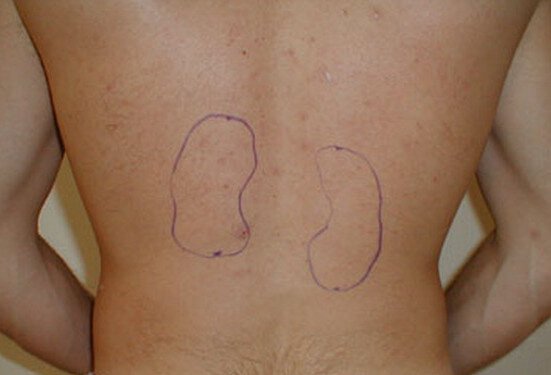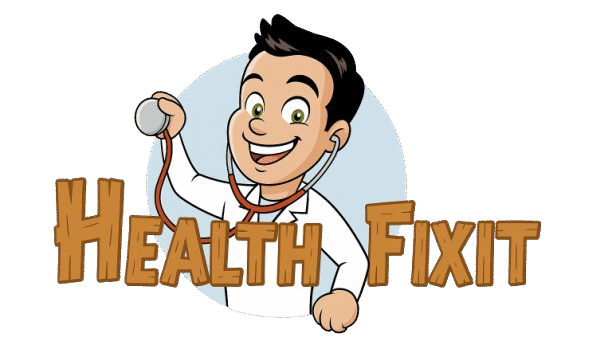Known mostly for their waste removing functions in our bodies, kidneys are bean shaped organs.
They look like two sprouting beans attached opposite each other and separated by venacava, the aorta, and other gastrointestinal organs.
Kidney Location (Anatomy)
- Anatomically, they are positioned on your back; or more precisely,
- Just under both the lower ribs (4 ).
- The areas may probably and clearly explained as the upper abdominal area but on the backside usually near the back muscles.
- They are intricately hidden in the abdominal region, right next to the liver and the spleen
- Owing to their peculiar opposite positions, both kidneys are on not the same level.
- The right kidney lies lower and just under the diaphragm, while the left kidney being slightly higher due to the large size of the liver.

Picture 1 : Where are the kidneys located in relation to quadrants?
The delicate and vital organs, are surrounded by layers of fat, and are protected by the ribcage, muscles, as well as each having a layer of connective tissues. On the back, they will feel as though they are deeply embedded on each side of the spine as depicted in the diagram below (1). See for Kidney pain location
On a surface, here is where the Kidney is found


Viewed from behind, the kidneys shown by the arrow and appear right at the inner part of the lower rib cage area. The left kidney is positioned higher on the rib cage area and next to the spleen. It may appear smaller in size in women and children as opposed to the male gender. The right kidney slightly lower is is not totally enclosed by the rib cage and liver and the lungs.

The above diagram shows the position of each kidney viewed from the front side.
Various Types of Kidney Pain
There are several types of pains attributed to the kidney, most of which are in the back area of your body and often in the upper region near the rib cage areas, just above the hips. Unlike the lower back pains that are most severe (5);
- Most kidney pains will be dull
- Felt on either side of the spine region.
- However, the pain can be quite painful especially when there is presence of kidney lacerations or kidney stones.
- One paramount difference with other back pains is that all kidney pains will be accompanied by high fevers, nausea and in some cases lead to vomiting.
- The pains caused by kidney stones will be wavy-like, moving from the upper backside to the front hip area (2).
- Unlike back pains that will restrict back movements, severe kidney pains are comparable to Labour pains, affecting the movement of every other part of the body.
- With back pains, one feels the pain on simple movements of the body; it actually becomes difficult to move. Kidney pains will be delayed after a move although in severe cases, the pain may be more elaborated and affect the body movements or exercises.
How to know if you are experiencing Kidney Pain
- Most kidney pains will be dull. This is especially when kidney disease is on the onset.
- With chronic kidney disease, the pain will however be severe.
- Since onset kidney pains are rarely specific, they can be confused with side organs pains such as the spleen, colon, or even the gallbladder.
- The only difference in these kidney pains is that they will be cramping.
- They may be sudden, recur once in a while or persist in chronic conditions.
- The pains will be felt on one side of the infected kidney or both sides of the back region in cases where both kidneys are infected.
- This pain will either throb, or just appear either once as sharp and deeply piercing pains that can be mild or in some cases quite severe .
- Severity of most other back pains increases with body movements. Kidney pains will be consistent and steady, body jerking, exercising will not alter the severity.
- To confirm if the pains are indeed related to kidney infections, the symptomatic pains will be accompanied by fever, fatigue, nausea, and most often, vomiting.
- The flank joint area will also be in pain or discomfort and especially the groin region.
- In case of pains caused by injury, there may be presence of injurious pain
- And if infections are the primary cause, the reproductive system will also be affected causing similar discomforts or most urinary tract diseases.
Kidney Stone Pains
- The sudden and severe kidney stone pain increases in intensity and usually comes in a wave (6).
- The pains will be elaborated in the groin or genital regions, moving to the abdomen and round at the back area. It is neither permanently in the stomach region nor at the back as the pain is forever shifting (3).
- The stones if small do not cause pains as they pass out through the urine. If large or many, they may however block the urinary tract in various place and therefore their sizes may not be signifanct to the pain felt. Since they are on the move, the pain will also be in various places in the urinary tract.
- Depending on the severity of the infection, the pains will also be more severe on the most affected area.
- Sharp pains that will abruptly be either on one back area or both or in the lower abdominal areas extending to the groin region.

Some of the Kidney Diseases and their Associated Pains
| Disease | Associated pain |
| Kidney stones | Pains are as indicated above usually begins as dull aches in the left or right back regions, extending to sharp and constant pains in hours. May also be accompanied by heavy breathing, nausea, and even blood in the urine. |
| Obstruction of Urethra | Congenital, infections and surgeries are the likely causes. Side back pains usually after having a drink. There may be a mass in the upper abdominal region that may also cause more pains. |
| Loin Pain Hematuria Syndrome | Caused mostly by infections, hormonal imbalances and frequent use of contraceptives, it mostly affect women. Persistent pains with burning sensations around the loin region with fever and nausea. The pain progreses into throbbing busts that gets worse with movements. |
There are several other kidney ailments but most, which are accompanied by flank pains. These ailments includes but not limited to various cancers of the urinary tract systems, renal cysts, nephrogenic diabetes, glomerulonephritis, hydronephrosis, and a host of other related kidney ailments. The remarkable difference in kidney pains with any other pains is that kidney pains will be accompanied by fever and nausea.
Difference between Kidney Pain and Back Pain
| Kidney Pain | Lower Back Pain |
| Sudden and consistent | May be sudden but persistent |
| On either backside, | Usually lower back |
| Pains moves to other regions | Pains mostly on one central area |
| Not affected by movement | Increases with body movement |
Causes of Bilateral and Unilateral Kidney Pains
Flank pains experienced in either one side otherwise known as unilateral, or both sides, which is referred to as bilateral is caused by various reasons (3).
- The most cause of kidney pains or flank pains is kidney stones.
- Obstructive uropathy. This is the process of having urine passing in the opposite direction usually because of blockages in the urinary tract.
- Pyelonephritis. This is the inflammation of the kidneys and the urinary tract.
- Urinary Tract Infections. Covering a wide range of infections, they affect the entire process of making and transporting the urine from the body.
- Appendicitis. Attached to the large intestines, this vital organ if full or inflamed will also cause flank pains.
There are several other causes of flank pains like bladder cancer, injuries, obesity related pains, obstructions on the renal tract, hydronephrosis, shingles, Hodgkin’s disease amongst others (7).
Does Kidney Failure Cause Pain
A progressive of kidney ailments causes kidney failure (8). Often irreversible, kidney failure is detectable through symptomatic causes that can be treated early but if progressed, the only remedy for kidney failures is transplants and dialysis. Owing to the fact that there may just be one kidney malfunction, the obvious symptoms may not be present and thus will go undetected. You will know it is chronic when both kidneys are affected (3).
- There may be little or no pain at this stage, directed exactly at the kidneys but because of the effects of a kidney failure, pains may be around the thoracic region due to fluids building up and shortness in breathing.
- In the initial phase culminating to kidney failure, there is the kidney pains associated with either each back pain or both sides of the spinal region.
- If the pains are related to infections, there will definitely be abdominal pains and if the kidney pains are as a result of kidney stones, most definitely severe pains in these kidney regions.
- Since it is rarely accompanied by pain, kidney failure will mostly be noticeable by (9)
- Nausea and vomiting,
- Fever and persistent itching,
- Fatigue and remarkable body weakness,
- Loss of weight and general malaise.
- The most distinguishing symptom is high and erratic blood pressure that is difficult to control,
- Frequent urination with a feeling of incontinence and sometimes accompanied by either dark coloured urine or with blood.
- There will also be remarkable swelling of the feet and especially the ankles,
- Muscle twitches and cramping as well as frequent hiccupping.
- Sleeping patterns will be adversely affected, resulting to long hours of sleeplessness that decreases the mental thinking capacity (3).
References
- Charles Patrick Davis P. Kidney Pain: Get the Facts About Symptoms and Causes [Internet]. MedicineNet. 2015 [cited 4 December 2015]. Available from: http://www.medicinenet.com/kidney_pain/article.htm
- Nhs.uk. Chronic kidney disease – NHS Choices [Internet]. 2015 [cited 4 December 2015]. Available from: http://www.nhs.uk/conditions/Kidney-disease-chronic/pages/introduction.aspx
- WebMD. The Basics of Kidney Disease [Internet]. 2015 [cited 4 December 2015]. Available from: http://www.webmd.com/a-to-z-guides/understanding-kidney-disease-basic-information
- Casteleijn, Niek F., et al. “Chronic kidney pain in autosomal dominant polycystic kidney disease: a case report of successful treatment by catheter-based renal denervation.” American Journal of Kidney Diseases 63.6 (2014): 1019-1021.
- Cohen, Debbie L., and Michael C. Soulen. “A Patient with Acute Kidney Pain and High BP.” Clinical Journal of the American Society of Nephrology (2015): CJN-10171014.
- Davison, Sara N., Holly Koncicki, and Frank Brennan. “Pain in chronic kidney disease: a scoping review.” Seminars in dialysis. Vol. 27. No. 2. 2014.
- Ksl.com/?sid=37320617&nid=1352&title=worst-pain-ever-childbirth-or-kidney-stones&s_cid=queue-7
- Webmd.com/news/20151105/early-warning-sign-for-kidney-disease-identified-in-study
- Sciencedaily.com/releases/2015/12/151203081800.htm
